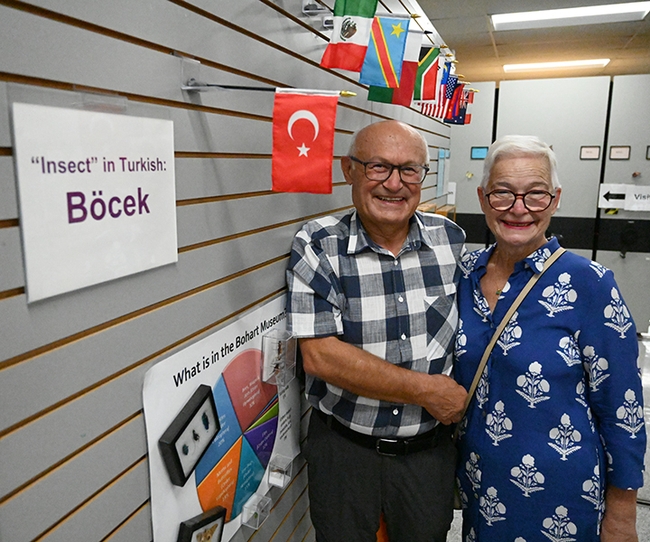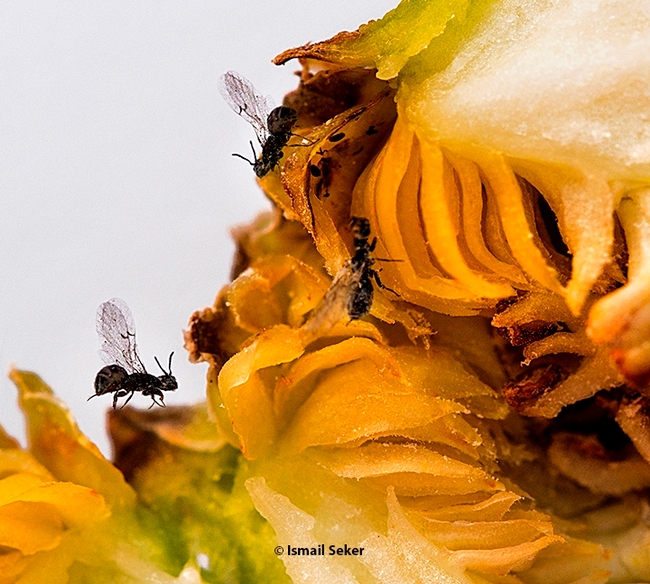How do you say "insect" in the Turkish language?
That's a question posed by the Bohart Museum of Entomology, University of California, Davis, on its wall display of global flags and languages.
That was an easy question for Dr. Ismail Sekur and his wife, Esin, who were among the special guests at the Bohart Museum's Sept. 25th open house, "Weird and Wonderful Wasps."
They are natives of Turkey.
Dr. Sekur, a physician, photographer and author, was displaying some of his fig wasp images that he took in Turkey. He and Esin, also in the health field, divide their time between their native land, and Davis, where their son, Erkin Seker, serves as a professor in the UC Davis Department of Electrical and Computer Engineering.
No stranger to the Bohart Museum, Dr. Sekur presented a program in 2019 on silkworm moths, displaying the eggs, larvae, pupae, adults, as well as silk fabric. He also displayed his newly published book on silkworms and shared his 13-minute video detailing the history of the silkworm moth and its life cycle. Dr. Sekur is currently working on books showcasing chestnuts, olives and figs.
But back to the global display of flags and how to say "insect" in other languages. (See website)
So, how do you say "insect" in the Turkish language? Böcek.
And the Turkish flag? It's red with a white star and crescent.
The open house drew widespread interest in the Asian giant hornet (aka "murder hornets") pteromalids, oak galls, and fig wasps, among others. "Fig wasps are among the weirdest insects I can think of both in their obligatory relationship with plants and the strange looking males," said Lynn Kimsey, director of the Bohart Museum and a UC Davis distinguished professor of entomology. "Females are winged and wasp-like; males on the other hand spend their entire lives in the fig fruits and look really strange and are wingless and often look like they only have four legs."
The Bohart Museum, located in Room 1124 of the Academic Surge Building, 455 Crocker Lane, is open to the public Monday through Thursday, from 9 a.m. to noon and from 1 to 5 p.m., except holidays. (See schedule). It houses a global collection of eight million insect specimens. It also is home to a live “petting zoo,” comprised of Madagascar hissing cockroaches, stick insects and tarantulas; and an insect-themed gift shop, which includes t-shirts, sweatshirts, jewelry, books, posters and other items. The gift shop is open all year-around and is also online. More information is available on the website at https://bohart.ucdavis.edu or by contacting bmuseum@ucdavis.edu.
Upcoming special events, all free and family friendly:
Saturday, Oct. 15, 1 to 4 p.m.
Insects, Art & Culture
Visitors will learn about insects through the lenses of art and culture. This event is part of Spirit Week (Oct. 10-16) for Aggie students, parents and alumni, but all are welcome.
Saturday, Oct. 15, 11 a.m. to 11:50 a.m.
Special Talk: Plants, Insects and Art: Mary Foley Benson's Scientific Illustrations
Location: Teaching and Learning Complex (TLC) Building, 482 Hutchison Drive, UC Davis campus
This event is part of Spirit Week for Aggie students, parents and alumni, but all are welcome. Srdan Tunic, a candidate for a master's degree in art history and a Bohart associate, will be highlighting the scientific illustrations of Mary Foley Benson (1905-1992), formerly of the U. S. Department of Agriculture's Bureau of Entomology and the Smithsonian Institution and who later worked for UC Davis entomologists. Much of her work appears on campus. (See research story on the artist by Malcolm Furniss)
Sunday, Nov. 6, 1 to 4 p.m.
Dragonflies Rule!
Dragonflies are described as "the ultimate predator both in the water and the air." Visitors will meet scientists and natural historians who will share information on the world of dragonflies.
Attached Images:

At the Bohart Museum of Entomology, Dr. Ismail Seker and his wife, Esin, stand in front of the Turkish flag and a card indicating how to say "insect" in the Turkish language. The Bohart Museum spotlights a global collection of flags, as well as how to say "insect" in many languages. (Photo by Kathy Keatley Garvey)

This image of fig wasps was among the spotlighted images at the Bohart Museum of Entomology's recent open house on wasps. (Photo by Dr. Ismail Seker, who captured this image in his native Turkey)